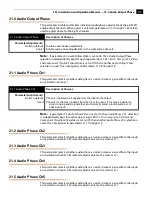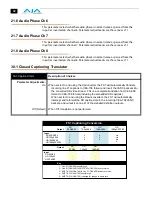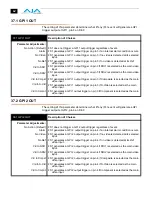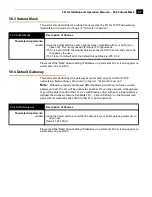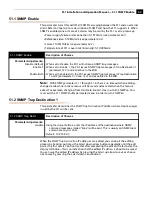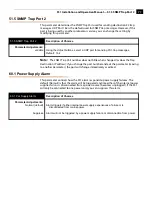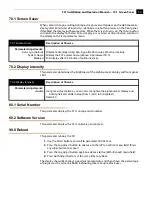
1
69
FS1 Installation and Operation Manual — 51.1 SNMP Enable
51.1 SNMP Enable
This parameter turns ON and OFF all SNMP messaging between the FS1 and an external
client. Refer to
Chapter 6
for a description of SNMP and how the FS1 supports it. When
SNMP is enabled, one or more of 4 alarms may be sent by the FS1 as a trap message:
•
Power supply failure or disconnection: fs1PSAlarm (see parameter
60.1
)
•
Reference video: fs1REFAlarm (see parameter
60.3
)
•
Format: fs1FMTAlarm (see parameter
60.2
)
•
Temperature of FS1 is over limit (internally): fs1OVRAlarm
Note:
With SNMP parameters
51.1
through
51.6
, there is no timeout when editing—
changes made while in these menus will be saved and activated when the menu is
exited. For example, changing from
Disable
to
Enable 1
does not turn SNMP on. You
must exit the
51.1 SNMP Enable
parameter menu in order to turn SNMP on.
51.2 SNMP Trap Destination 1
This parameter determines the
SNMP Trap Destination
IP address where trap messages
issued by the FS1 will be sent.
When the
SNMP Trap Destination
IP addresses are edited, you can abort the editing
process by backing out (press the
Select
down arrow button repeatedly until the edit
passes the first octet). You’ll notice that after completing the edit on the last octet, the
display will blink—this is an indication that the edited IP address is about to be saved.
You can save the edited IP address by pressing the
Select
up arrow to save or choose
not to save by pressing the
Select
down
arrow button.
51.1 SNMP Enable
Description of Choices
Parameter Adjustments:
Disable
(Default)
Enable 1
Enable Both
When set to
Disable
, the FS1 will not issue SNMP trap messages.
When set to
Enable 1
, the FS1 issues SNMP trap messages to Trap Destination 1
(parameter
51.2
) and as defined in the MIB.
When set to
Enable Both
, the FS1 issues SNMP trap messages to Trap Destination
1 and 2 (parameters
51.2
and
51.4
) and as defined in the MIB.
51.2 SNMP Trap Dest 1
Description of Choices
Parameter Adjustments:
variable
Using the
Adjust
buttons, enter the IP address of the destination where SNMP
command messages (called “traps”) will be sent. This is usually an SNMP client
somewhere on your LAN.
Default:
192.168.0.3
Содержание FS1
Страница 4: ...iv ...
Страница 28: ...18 ...
Страница 86: ...76 ...
Страница 120: ...110 ...
Страница 140: ...130 ...



